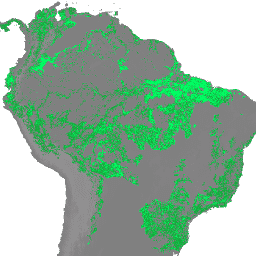
- 데이터 세트 사용 가능 기간
- 2017-04-08T00:00:00Z–2019-05-18T00:00:00Z
- 데이터 세트 제공업체
- World Resources Institute / Global Forest Watch
- 태그
설명
WRI 참고: WRI는 FORMA 알림 업데이트를 중단하기로 결정했습니다. 목표는 Global Forest Watch 사용자 환경을 간소화하고 중복을 줄이는 것이었습니다. Terra-i와 GLAD가 더 자주 사용되는 것으로 확인되었습니다. 또한 GLAD를 표준으로 사용하여 Terra-i가 전 세계적으로 FORMA보다 성능이 우수함을 확인했습니다.
FORMA 알림은 NDVI (정규 식생 지수)와 FIRMS(자원 관리 시스템용 화재 정보)라는 두 가지 MODIS 제품을 조합하여 감지됩니다. NDVI 업데이트는 16일마다 처리되고 화재 업데이트는 매일 처리됩니다. 모델은 각 생태 그룹에 대해 개별적으로 개발되어 두 입력을 벌채 지역과 연결하며, Hansen 연간 나무 덮개 손실 데이터를 사용하여 모델을 학습시킵니다. 경고로 간주되는 최소 기준점은 픽셀의 25% 가 지워진 경우입니다. 하지만 오탐을 최소화하기 위해 기준점은 ecogroup에 따라 다릅니다. 다음은 FORMA 데이터 세트를 간략하게 소개하는 예시 스크립트입니다.
이 ImageCollection의 이미지는 새로운 MODIS FIRMS 데이터를 사용할 수 있게 된 후 계산된 원시 FORMA 데이터를 포함하며, 이는 거의 매일 발생합니다.
각 대역은 다양한 누적 기간에 대한 소거 비율 (0~100)을 나타냅니다. 'N'은 최신 FIRMS 업데이트와 이전 NDVI 업데이트 사이의 일수입니다. N은 'date_delta' 속성으로 제공됩니다.
대역
픽셀 크기
250미터
대역
| 이름 | 단위 | 최소 | 최대 | 픽셀 크기 | 설명 |
|---|---|---|---|---|---|
nday |
% | 0 | 100 | 미터 | 지난 N일 동안의 결제 비율 |
delta_nday |
% | 0 | 100 | 미터 | 지난 96+N일 동안의 결제 비율 |
near_term_delta_nday |
% | 0 | 100 | 미터 | 지난 32+N일 동안의 결제 비율 |
이미지 속성
이미지 속성
| 이름 | 유형 | 설명 |
|---|---|---|
| 년 | INT | 데이터 세트에 포함된 가장 최근 데이터의 연도 |
| 날짜 | 문자열 | 이 데이터 세트에 포함된 마지막 MODIS FIRMS 데이터의 날짜입니다('YYYY-MM-DD' 형식). |
| date_delta | INT | 날짜와 previous_biweekly_date 사이의 일수 |
| previous_biweekly | INT | 최신 MODIS NDVI와 관련된 연도의 격주 (16일마다) 기간 |
| previous_biweekly_date | 문자열 | 최신 MODIS NDVI 업데이트와 관련된 날짜 |
이용약관
이용약관
FORMA 데이터 세트는 사용 또는 배포에 제한이 없습니다. WRI는 사용자가 적절한 저작자 표시를 제공하고 해당되는 경우 WRI와 GFW를 데이터 소스로 식별하도록 요청합니다.
Earth Engine으로 탐색하기
코드 편집기(JavaScript)
var dataset = ee.ImageCollection('WRI/GFW/FORMA/raw_output_firms') .filter(ee.Filter.date('2018-08-01', '2018-08-15')); var percentageOfClearing = dataset.select('nday'); var visParams = { min: 0.0, max: 0.01, }; Map.setCenter(26, -8, 3); Map.addLayer(percentageOfClearing, visParams, 'Percentage of clearing');
